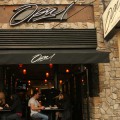Ibi Oluwole took a measured risk moving her modish little clothing boutique last year to the Willow Glen Town Center. Overhead at the swanky new plaza, the retail capstone of San Jose’s Lincoln Avenue, cost the 26-year-old owner of Ibiss far more than her previous address.
“It is a lot more expensive here,” admits Oluwole, whose lease has a clause that prevents her from sharing details. But her old location, in a mid-century building just blocks away from her new digs at 1100 Lincoln Ave., paled in comparison to what she has now.
“The address is a huge plus,” she says. “There’s a lot more foot traffic, a lot more visibility here. The developers have done a really good job of promoting this as more of an upscale destination. I see a lot more foot traffic, which translates to more sales.”
While most cities in California have seen development stall in the last few years, thanks to the recession and the dissolution of state’s redevelopment agencies (RDAs), which redirected property taxes to turn blight into private-public partnerships, Willow Glen has become an outlier, a DIY business community.
In 2009, the Willow Glen Business Association, a group of 400-plus landlords and entrepreneurs, levied a tax on themselves to pay for enhanced city services. Property owners paid the self-elected tax in exchange for things like street and sidewalk cleaning, wine walks and pub crawls, and decorative banners to post on the old-fashioned street lamps that line “The Avenue.” The assessment funds what’s called a Community Benefit Improvement District, a nonprofit entity that ensures Willow Glen gets the perks it pays for.
Despite the extra cost, which landlords pass down to tenants like Oluwole, many businesses in Willow Glen are benefiting from the 30,000-square-foot Willow Glen Town Square, owned by developer Alex Byer, since it opened on the corner of Willow Street and Lincoln Avenue.
Byer could have taken the easy route and demolished all buildings on the site and imported new tenants. Instead, he carefully incorporated the legacy one-story brick Willow Street Wood Fire Pizza structure into his complex, built a new space for existing tenant Willow Glen Frozen Yogurt and Ice Cream Co., attracted owner-operated Ibiss from down the street and brought one of San Jose’s oldest restaurants out of retirement. By the time of its grand opening last November, the two-story, tan-and-beige, Mediterranean-style structure, bedecked out front with a dining patio and fountain, had become the community’s visual and economic cornerstone. Dozens of tenants, including Ibiss, fill what amounts to more than a city block of office and retail space.
Without government intervention or big national retail developers, Willow Glen has quietly become on of the most attractive new addresses in San Jose, and amazingly, private citizens are footing the bill.
Where You From?
Willow Glen residents are provincial. Ask a person if they live in Willow Glen or San Jose, and they’re unlikely to name-drop the latter. Few communities in the city claim such a sense of independence, a holdover from Willow Glen’s days as a separate town before an archaic sewer system forced it to incorporate before residents voted in 1936 to be annexed to San Jose rather than raise money to build a sewer system.
Since that time, few grand plans for public transit, redevelopment subsidies, tax breaks or sustainable mixed-use magic have helped this quaint city corridor.
“It’s really a testament to the power of organic growth through private investment,” says San Jose City Councilmember Pierluigi Oliverio, whose district encompasses Willow Glen, where he was born and raised, and Cambrian.
Michael Mulcahy, a third-generation Willow Glen resident and property owner since 1996, credits the new benefit district with helping his neighborhood pull out of the recession.
“I think our timing was exquisite,” says Mulcahy, a former San Jose mayoral candidate who leases his Garden Theater and 10 other buildings to about 50 tenants on the half-block corner of Lincoln and Willow. “We were coming out of a deep, dark recession, but as the city’s coffers continued to dwindle and they went about cutting public services, we had already approved the [district].”
There have been naysayers. Domus, an established culinary supplies shop on the corner of Lincoln and Minnesota avenues, shuttered last fall—after the landlord asked for thousands a month more in increased rent. Other businesses have also complained that the district priced them out of the neighborhood. But most tenants remain, and the vacancies quickly filled.
Tim Muller, who co-owns Lou’s Village, a six-decade-old restaurant that relocated to move into the new town square, says that the ambience and additional walk-in customers are the cost of doing business. And Gary Rovai, who has owned the historic Goosetown Lounge for the better part of two decades, agrees that the district asks for a nominal fee for tangible benefits—even if the cozy dive bar resides a few blocks away from the town center.
“There’s just a lot more things going on that draw in customers,” Rovai says. “Even us, who’ve been here for ages.”
DIY Community
Mulcahy served as president of the Willow Glen Business Association (WGBA) in 2008, when talk of forming a community benefit district first came up. At the time, the district received public funds based on the area’s business permitting fees and subsequent taxes paid to the city’s Finance Department. The payout came up to twice a year.
“It was very unreliable,” Mulcahy says.
The city would announce a tax amnesty every four to five years to encourage delinquent businesses to get back on the rolls penalty-free. The amnesty meant a loss of up to a third of Willow Glen’s revenues for public services.
“That was our money; we should have had that coming in,” Mulcahy says. “The city wasn’t collecting it, so we decided to do something on our own.”
Through Mulcahy’s direction and Oliverio’s support, the business association teamed up with New City America, a private company that has helped form about 20 percent of California’s 400 community benefit districts. Oliverio then snagged a council grant to present the idea to voters, which passed by a slim margin.
“But we won,” Mulcahy says. “And you know, we needed that to make sure we could stay competitive as a community.”
Destination shopping centers like Santana Row, indoor malls and plazas often have only one property owner. They control garbage collection, signage and cleanup crews. They also get to hire extra security or off-duty officers, and the concerted management creates an orderly system.
“People forget that a district like Willow Glen is in direct competition with places like that,” Mulcahy says. “The difference is that we’re a bunch of independent businesses with many different property owners, so we have to organize ourselves to come up with an effective way to manage things.”
WGBA fees come out to about $200,000 to $300,000 a year, and the business association contributes funds through events like the Willow Glen Wine Walk and holiday celebrations. With this money, the board establishes a uniform look, feel and focus for the district while still trying to retain its small town identity.
A National Trend
Though only the second property-based benefit district of its kind in San Jose, approximately 2,000 have cropped up around the country, says Marco Li Mandri, head of New City America. His firm established nine neighborhood improvement districts in San Francisco, recognized for its distinct “microhoods.”
“What we’ve seen nationwide for years now is that revenues that have previously existed, whether in city or redevelopment coffers, aren’t there anymore,” says Li Mandri. “The first thing we hear when we’re talking about federal budget cuts is that they’ll cut state grants; those are first in line, and that trickles down to the local level.”
More self-improvement districts like Willow Glen’s are expected to pop up in the near future, as other San Jose communities—such as West San Carlos Street, also in Oliverio’s district—could attempt to copycat trends like Japantown, which itself is poised for new development.
“I think these districts are going to be important for the future, not just for San Jose, but for communities throughout the United States to remain safe clean and competitive,” Mulcahy says. “In some ways, you’re creating a gated community without the gate.”

 Persuasion at The Stage
Persuasion at The Stage  Menlo Park Approves New Facebook Campus
Menlo Park Approves New Facebook Campus 


